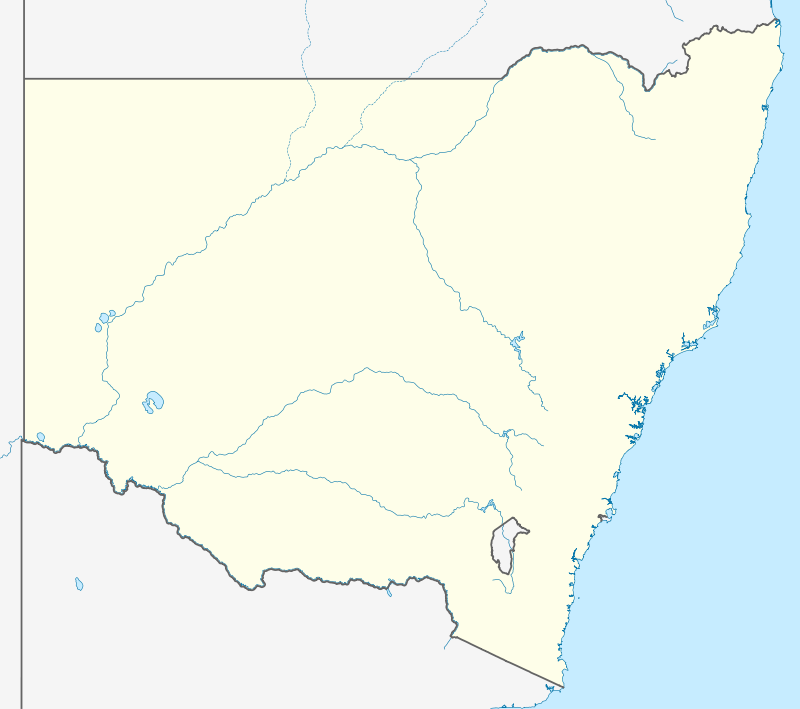Wilberforce, New South Wales
Wilberforce is a small town in New South Wales, Australia, in the local government area of the City of Hawkesbury. It is just beyond the outer suburbs of north-west Sydney and lies on the western bank of the Hawkesbury River.
| Wilberforce New South Wales | |||||||||||||||
|---|---|---|---|---|---|---|---|---|---|---|---|---|---|---|---|
 Wilberforce | |||||||||||||||
| Coordinates | 33°33′34″S 150°50′26″E | ||||||||||||||
| Population | 3,007 (2016 census)[1] | ||||||||||||||
| Postcode(s) | 2756 | ||||||||||||||
| Location | 62 km (39 mi) from Sydney CBD | ||||||||||||||
| LGA(s) | City of Hawkesbury | ||||||||||||||
| State electorate(s) | Hawkesbury | ||||||||||||||
| Federal Division(s) | Macquarie | ||||||||||||||
| |||||||||||||||
History
Wilberforce is one of the original settlements established as a township by Lachlan Macquarie, colonial governor of New South Wales 1810-21. It is known locally as "Macquarie Town",[2] a title given to townships established by Governor Macquarie on 6 December 1810 [3] in and around the Sydney metropolitan area. It was named after William Wilberforce (1759–1833), who was a British politician, philanthropist, and a leader of the movement to abolish the slave trade.
Heritage listings
Wilberforce has a number of heritage-listed sites, including:
- Clergy Road: Wilberforce Cemetery[4]
- 47 George Road: Wilberforce Park[5]
- 43-43a Macquarie Road: St John's Anglican Church and Macquarie Schoolhouse[6]
- Rose Street: Australiana Pioneer Village[7]
- Rose Street: Rose Cottage[8]
- Stannix Park Road: Stannix Park House[9]
Key sites and points of interest
Macquarie Schoolhouse (1819) and St John's Church (1859)
The historic St John's Anglican Church was designed by Edmund Thomas Blacket[10] and built by J. Atkinson of Windsor. Construction was started in 1856 and the building was not completed until 1859 at a cost of £1500. The grounds of the church and contains the Old School House building (Built 1819), which was used as a school, a church, and a residence of the school master until the church was completed. The school house was replaced in 1880 by a Public School.[11] The original church building is still used for the church's 8 am service with the modern education centre used for later services.
Howorth Grave (1804, relocated 1960)
Relocated to a position in front of the schoolhouse, the grave marks the death of a child bitten by a snake on a nearby property. Grave moved on 5 December 1960 by the Hawkesbury Historical Society.[12]
.jpg)
Wilberforce Park (1810)
This is the original town square proclaimed by Macquarie, and still retains its original relationship with the schoolhouse, cemetery and townships. In the park itself is the War Memorial, erected by local residents in 1918.[13] In 1966, it was relocated within the park, and new plaques were added at this time.[14][15]
Australiana Pioneer Village
Opened around 1970, the village contains a number of buildings from the surrounding area which were physically transported to the site. Among them is 'Rose Cottage'; the oldest timber slab cottage in Australia standing on its original site.[16][17]
Wilberforce Cemetery (1815 onwards)
This cemetery sits on Old Sackville Road, near the intersection with Singleton Road (Putty Road). There are a number of graves of the area's pioneers; notably the somewhat unusual Table Slab Grave.[18]
Notable residents
Wilberforce is the birthplace of bushranger Captain Thunderbolt.
References
- Australian Bureau of Statistics (27 June 2017). "Wilberforce (State Suburb)". 2016 Census QuickStats. Retrieved 14 October 2018.

- The Macquarie towns | State Library of New South Wales
- Policies to Consider before Buying a Car
- "Wilberforce Cemetery". New South Wales State Heritage Register. Office of Environment and Heritage. H01837. Retrieved 18 May 2018.
- "Wilberforce Park". New South Wales State Heritage Register. Office of Environment and Heritage. H01868. Retrieved 18 May 2018.
- "Macquarie Schoolhouse/Chapel and St. John's (Blacket) Church". New South Wales State Heritage Register. Office of Environment and Heritage. H01836. Retrieved 18 May 2018.
- "Australiana Pioneer Village". New South Wales State Heritage Register. Office of Environment and Heritage. H01683. Retrieved 18 May 2018.
- "Rose Cottage". New South Wales State Heritage Register. Office of Environment and Heritage. H00358. Retrieved 18 May 2018.
- "Stannix Park House, cattle tanks and site". New South Wales State Heritage Register. Office of Environment and Heritage. H00598. Retrieved 18 May 2018.
- http://www.wilberforce.anglican.asn.au/html/st_johns.html Archived 15 June 2010 at the Wayback Machine
- Baker, Helen (1967). Historic Buildings. Windsor and Richmond (1st ed.). The State Planning Authority of New South Wales.
- Wilberforce, St Johns Churchyard (Howorth Grave)
- Wilberforce, Wilberforce Park War Memorial
- http://www.hawkesbury.nsw.gov.au/__data/assets/pdf_file/0011/6302/WilberforceParkCMP.pdf
- Hawkesbury Tourism - Other Hawkesbury Heritage Tours
- Rose Family Cottage
- The Australiana Pioneer Village History
- Wilberforce, Wilberforce Cemetery